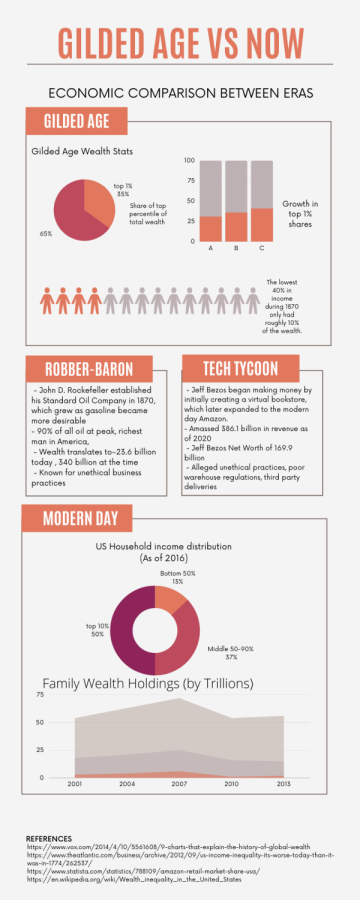Comparing eras: how modern tech titans resemble historical monopolizers
Although there are many noticeable differences between the 1800s and the 2020s, the wealth disparity is still prominent.
February 2, 2022
Throughout history, the growth of technology has always flourished throughout America. From the Industrial Revolution to the Gilded Age, it’s no debate that technological innovation has enhanced the way we live our lives today.
From using powerful supercomputers to driving reliable electric cars, everyone would simply not be able to sustain their families, lifestyles, and jobs without the help of modern innovation.
“I would say I heavily rely on modern technology every day, typically for five to six hours daily. I think the biggest tech companies I use the most are Apple and Microsoft, and without their products, life would be difficult and significantly less convenient,” said Ryan Co (‘22).
With so much monetary investment into tech industries, it’s no surprise that reigning modern Tech Tycoons such as Jeff Bezos, Elon Musk, and Mark Zuckerberg are absorbing large sums of profit from the technology we purchase.
This is obviously expected given the sheer size of their economic dominance, but lately, these “Tech Titans” businesses have begun to resemble historical robber-barons of the Gilded Age, or powerful industrialists that monopolized massive industries via trusts, exploited workers, and endorsed unethical business practices.
“While businesses during the gilded age had a much larger influence in their industries and in politics than the current massive corporations that come to mind, I do not think it would be unreasonable to say there is continuity between the gilded age and now,” said AP US History student Jeremy Li(23’).
Nineteenth-century champions of industrialization during the gilded age such as Andrew Carnegie, who revolutionized the mass production of steel, John D. Rockefeller, who established the multi-million dollar Standard Oil Company, allowed America to become an economic powerhouse.
While industrialization was largely beneficial, it also stretched the wealth gap, gave rise to huge market-consuming monopolies, and gave rise to internal business corruption- traits that all describe modern tech industries today.
“Big tech companies today still dominate their respective industries. While it may not be as competitive as it was before, there are often one or two big companies we all associate with some tech. For example, for networking and Wi-Fi, most people would think of Cisco, which shows exactly how dominant companies are regardless of any changes,” said Cisco Software Development Manager Shu Xiao.
The growing disparity in income and wealth rates between the rich and middle class is a direct effect of growing tech companies.
With the wealth gap now growing as wide as it was a century ago, it’s no surprise that many consider today a modern gilded age.
“The wealth of the richest billionaires is growing exponentially compared to the already ridiculous inflation rate. Just like in the gilded age, I do not expect these conditions to be livable in a couple of decades’ time and believe that reform movements will begin having a greater influence. Both time periods show technology expanding at a greater rate than ever before, but also have hidden underlying economic and social issues [like] the wealth gap.” said Li.
While the wealth gap as a result of booms in the tech industry is purely a national issue, its effects vary across different regions of the US.
While it has become apparent in urban environments such as New York and Chicago, Pleasanton seems to lack any clear definition of an income disparity. With an average home value index of around 1.5 million, the town is definitely one of a select few.“Pleasanton is a very affluent community when compared to the rest of the United States. All of us know about the massive housing prices. While there are definitely many families experiencing economic hardships, I would think that simply still being able to live here would show that it is not a paycheck to paycheck situation – we experience it, but are not the biggest victims,” said Li.





